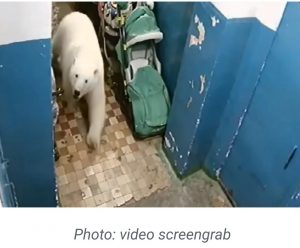There is tension in a small Russian town as dozens of polar bears are chasing out people from their homes after invading the town.

Those who managed to find out the situation on time have locked themselves inside, now afraid to leave their homes as the Polar bears roam the streets.
The small town of Belushya Guba, in northern Russia, is in a state of emergency, as residents are unwilling to leave their houses because of dozens of polar bears roaming the streets in search of food.
The hungry polar bears have caused a state of emergency on the remote community where they are breaking into buildings and chasing terrified residents.
At least 52 bears were spotted near the settlement of Belushya Guba on Novaya Zemlya, according to an official statement by the Arkhangelsk region that encompasses the area.
People are “afraid to go outside” and “daily life is in turmoil,” local administrator Aleksandr Minayev told the Siberian Timeson Tuesday.
Novaya Zemlya is a set of two Arctic islands off of Russia’s northern coast. Now home to roughly 3,000 people, it was once a Soviet nuclear test site where the 50 megaton Tsar Bomba, or “king of bombs”—the largest ever man-made explosion—was detonated in 1961.
An official emergency was declared by officials on Sunday to address the invasion, which started in December 2018. Locals have complained that “six to ten” polar bears are constantly in the village, entering people’s homes and offices and generally causing terror.
Fences and loud noises, such as gunshots and car horns, have failed to scare off the bears.

“I have been in Novaya Zemlya since 1983, but there have never been so many polar bears in the vicinity,” local administrator Zhigansha Musin told Russian news agency TASS on Saturday. Musin added that bears have taken over a military garrison where they “literally chase people.”
Reports have blamed this behavior on climate change, as dwindling sea ice is known to force the predators onto land for food.
“There is no question: this has been a very difficult year for bears in that part of the world,” Andrew Derocher, a professor at the University of Alberta who studies polar bears in the Arctic, told Motherboard over the phone.
Polar bears spend the majority of their time on ice sheets, hunting seals that surface for air. When the ice recedes during warmer months, the bears will move inland until it reforms.
Derocher monitors sea ice in the region and called this year’s freeze-up “by far most bizarre” he’s seen, with ice appearing extremely late, and delayed three to four months in certain parts.
A rapidly melting Arctic has thrown polar bear distribution out of whack, Derocher explained. “It’s sort of like, you go to a restaurant and the restaurant is closed,” he said. “So where do you go? You keep wandering until you find one that’s open.”
Climate change has increased the number of ice-free days in many Arctic regions, according to a 2016 study by international researchers published in the Cryosphere. NASA measurements show that Arctic sea ice is now declining at a rate of 12.8 percent per decade, relative to the 1981 to 2010 average.
As a result, confrontations between humans and polar bears are happening more frequently.
Source: Motherboard
 Wakki News The weird is fun
Wakki News The weird is fun





